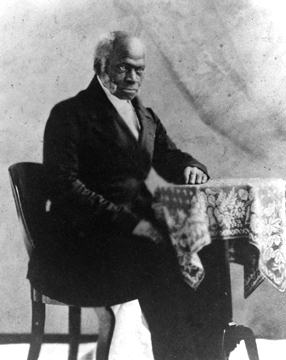Pierre Toussaint facts for kids
Quick facts for kids VenerablePierre Toussaint |
|
|---|---|
 |
|
| Born | 27 June 1766 Saint-Marc, Artibonite, Saint-Domingue (now Haiti) |
| Died | 30 June 1853 (aged 87) New York City, U.S. |
| Major shrine | St. Patrick's Cathedral |
| Spouse(s) | |
Pierre Toussaint was a kind and generous man who lived from 1766 to 1853. He was born in Haiti and came to New York City in 1787. He was a hairdresser and gave a lot of money to help others. The Catholic Church has declared him "Venerable", which is a step towards becoming a saint. Pope John Paul II gave him this title in 1996.
Pierre became free in 1807. He chose the last name "Toussaint" to honor a hero of the Haitian Revolution. He was a very good hairdresser and used his money to help many people. He even helped pay for building a church called St. Patrick's Old Cathedral.
Many people say he helped start Catholic Charities in New York. Pierre Toussaint is the first person who was not a priest or bishop to be buried under the main altar of Saint Patrick's Cathedral on Fifth Avenue. This special burial place is usually only for bishops.
Contents
Biography
Early life and move to New York
Pierre was born on June 28, 1766, in what is now Haiti. He was born into slavery on a plantation owned by the Bérard family. His mother's name was Ursule. He also had a sister named Rosalie.
Pierre was raised as a Catholic. He learned to read and write from the Bérard family's teachers. In 1797, as the Haitian Revolution began, the Bérard family moved to New York City. They brought Pierre and his sister Rosalie with them.
Life in New York
In New York, Pierre became an apprentice to a leading hairdresser. His master, Jean Bérard, later died. Pierre, who was becoming a successful hairdresser, chose to support Madame Bérard, his master's wife. He had been allowed to keep some of his earnings.
Madame Bérard later remarried. On her deathbed, she asked her new husband to free Pierre. Pierre became a free man in 1807. He was a very popular hairdresser among New York's wealthy families. He saved his money and even bought his sister Rosalie's freedom.
Pierre became good friends with Catherine Church Cruger, a well-known woman in New York society. He also wrote many letters to the Bérard family in France and to friends in Haiti. These letters helped tell his life story.
Marriage and family
On August 5, 1811, Pierre married Juliette Noel. He had bought her freedom before they married. They lived together for many years.
Pierre and Juliette adopted Euphemia, the daughter of Pierre's late sister Rosalie. They raised Euphemia as their own child. They made sure she went to school and had music lessons.
Charity work
Pierre and Juliette Toussaint spent their lives helping others. They often took baked goods to children at an orphanage. They also gave money to help the orphanage run.
Pierre went to Mass every day for 66 years at St. Peter's in New York. He owned a house where the Toussaints took in orphans and helped many boys. They made sure these boys got an education and learned a trade. Pierre even helped them find their first jobs.
They also helped people find work and gave shelter to priests and travelers who needed a place to stay. Many people from Haiti came to New York. Because Pierre spoke both French and English, he often helped these new immigrants. He was known for helping people who were sick with cholera during an epidemic.
Toussaint also helped raise money to build St. Patrick's Old Cathedral in New York. He supported the first Catholic school for Black children in New York City.
Later years
Euphemia, Pierre and Juliette's adopted daughter, died before them. Juliette died on May 14, 1851. Pierre Toussaint died two years later, on June 30, 1853, at 87 years old. He was buried with his wife and Euphemia.
Veneration
Steps to sainthood
- In the 1950s, a group called the John Boyle O'Reilly Committee began to share Pierre Toussaint's life story. They wanted more people to know about his good deeds.
- Later, Cardinal Terence Cooke, who was the Archbishop of New York, allowed a committee to study Pierre's life even more.
- In 1991, Cardinal John O'Connor strongly supported Pierre for sainthood. He started the official process, giving Pierre the title of "Servant of God". Cardinal O'Connor sent all the information to the Vatican.
- As part of this process, Pierre Toussaint's body was moved to a special burial place. He was the first person who was not a priest or bishop to be buried under the main altar of St Patrick's Cathedral. This crypt is usually only for bishops of the Archdiocese of New York.
- In 1996, Pope John Paul II declared Pierre Toussaint "Venerable". This was the second step on the path to becoming a saint.
Legacy
- In 1854, a book called Memoir of Pierre Toussaint, Born a Slave in St. Domingo was written about his life.
- The Pierre Toussaint Haitian-Catholic Center in Miami, Florida, is named after him.
- Toussaint Academy San Diego is a school for homeless young people aged 14–18. It helps them have a stable place to live and learn.
- Pierre Toussaint is remembered for his good works in portraits at Gracie Mansion in New York City.
- In April 2021, a large part of Church Avenue in Brooklyn, New York was renamed Pierre Toussaint Boulevard.
- The intersection next to St. Peter's in Manhattan, where Toussaint attended church, was named after him in 1998.
- Sacred Heart University in Fairfield, Connecticut, has a residence hall named Pierre Toussaint Hall.
See also
 In Spanish: Pierre Toussaint para niños
In Spanish: Pierre Toussaint para niños
- List of American candidates for sainthood

